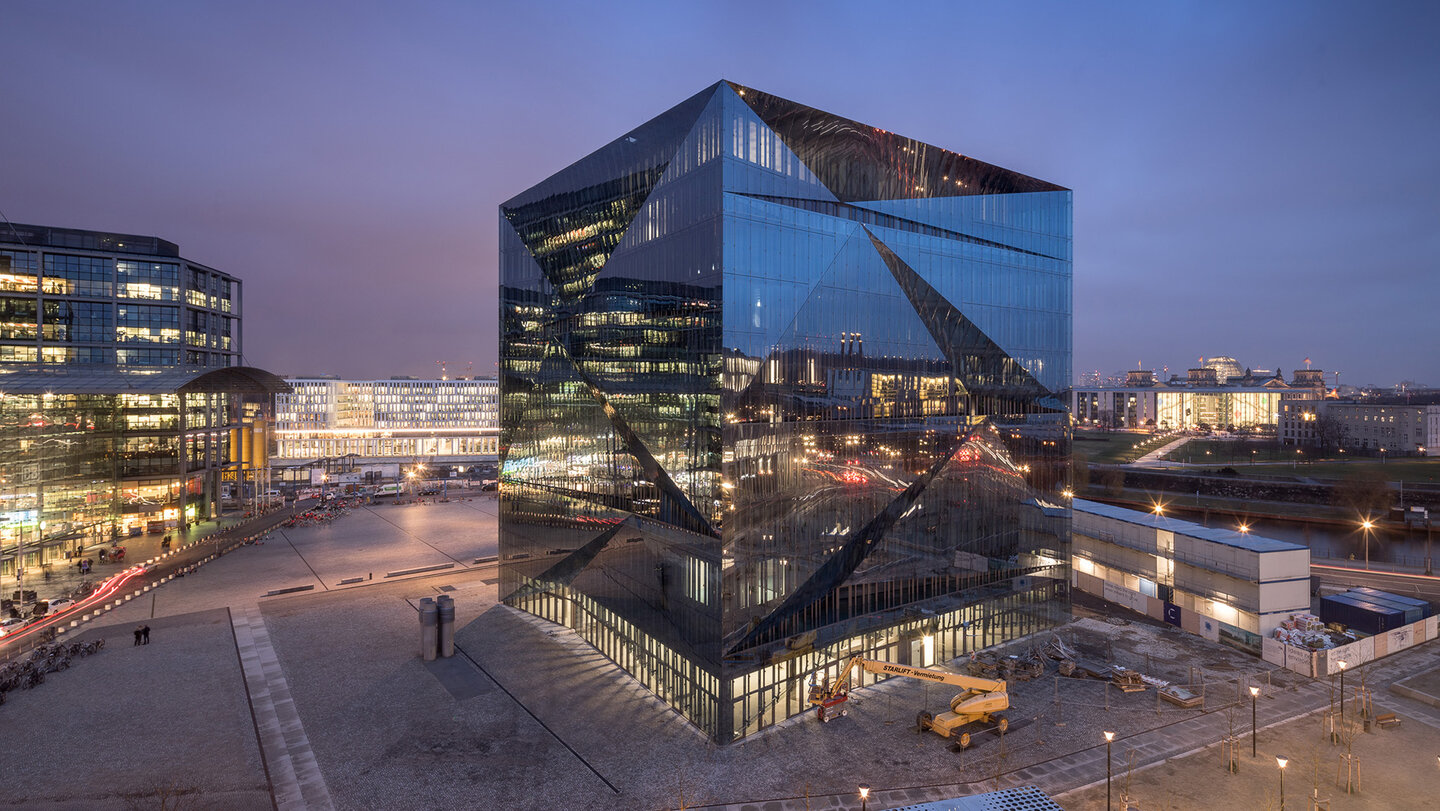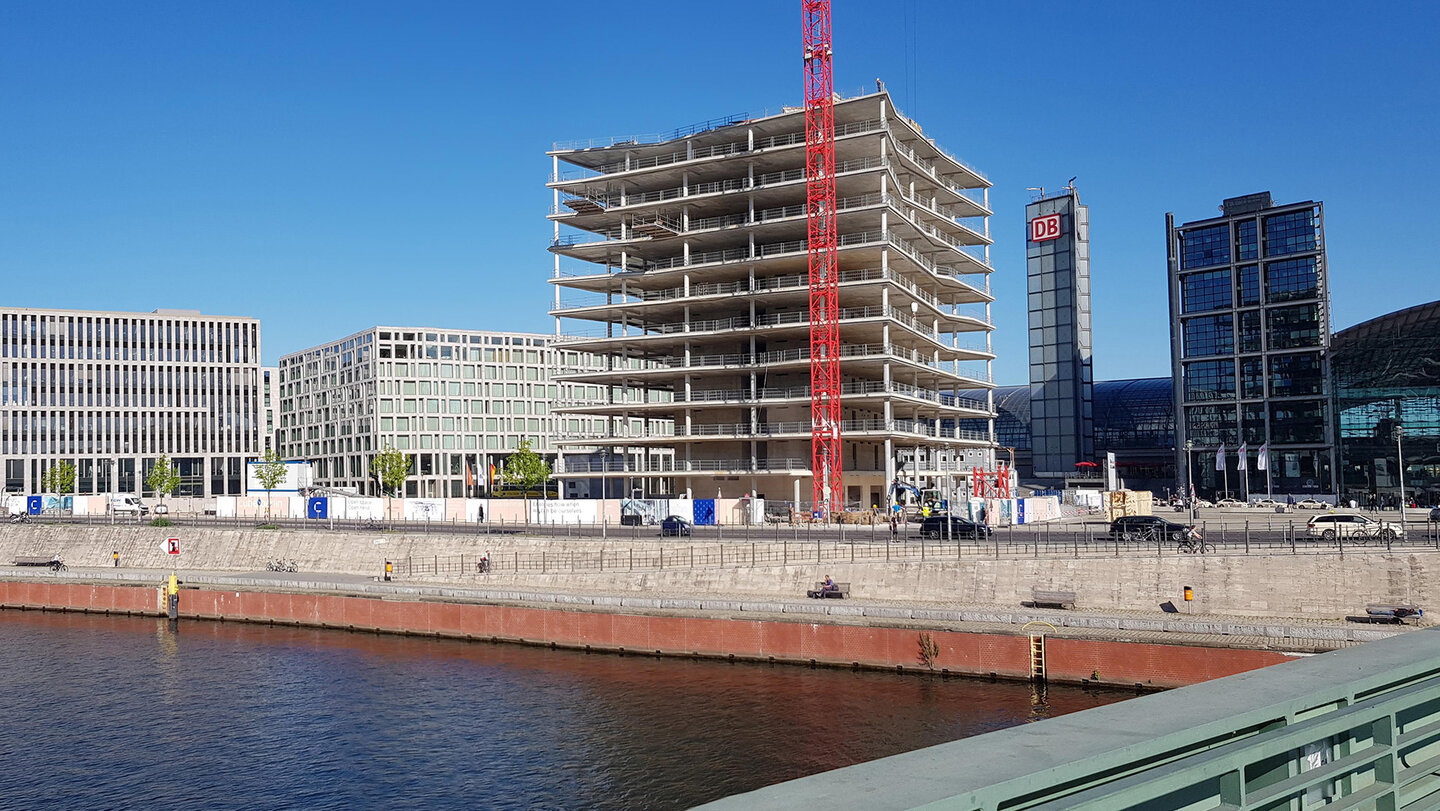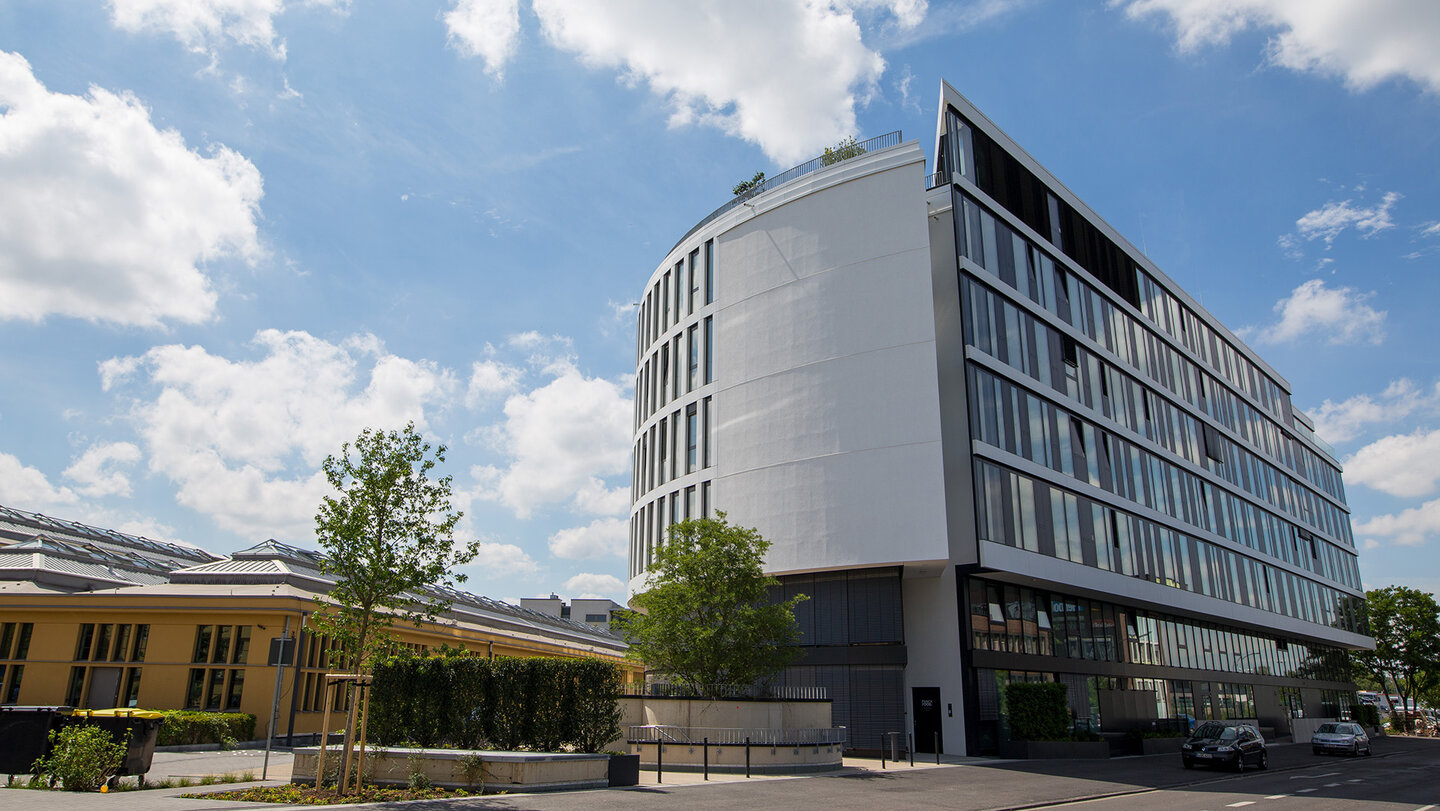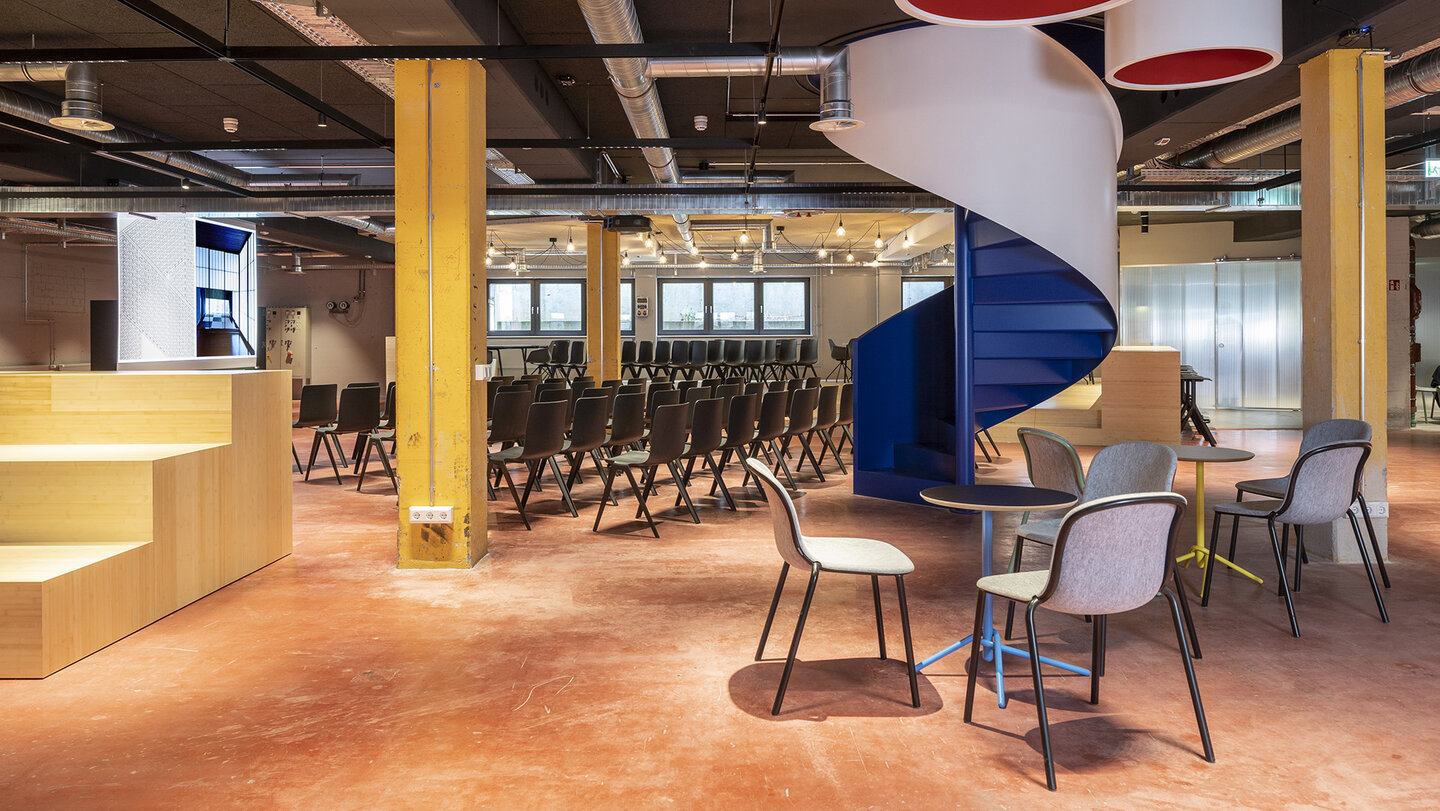With sensors in office buildings that collect user data to optimize building operations, Customized Smart Buildings are revolutionizing the property sector. What’s more, pilot projects are showing that they are reliable too.
By Klaus Dederichs, Partner and Head of ICT at Drees & Sommer
In the middle of Berlin, you’ll find a modern cube wrapped in a glass façade. This is cube berlin, a building that opened in February this year. Developed by CA Immo and with planning and consulting support from Drees & Sommer and the PropTech Thing-it, it’s certainly a stand-out piece of architecture. But the
really innovative thing about it isn’t visible from the outside. In fact, it’s literally packed with intelligence and smart technology – in full compliance with the highest safety standards. cube berlin has about 3,750 sensors and 750 beacons (transmitters with antennae running on Bluetooth Low Energy), which collect a wide range of data that enables the building to be controlled by computers.
A central control unit equipped with artificial intelligence (AI) – the so-called “Brain” – connects and processes many of the technical systems, sensors and planning, operating and user data. Once the information and data have been analysed and evaluated, it makes recommendations about how to optimize
processes within the building. For example, the system can identify unused spaces within the office and can switch off heating, ventilation, air conditioning or lighting in these areas. This helps to increase energy efficiency whilst also making the office more comfortable for users. As such, smart buildings create a fusion of technology, architecture and environment to enable a smarter future for both workers and their surroundings
cube berlin
 © Adam MØrk
© Adam MØrk
Construction of cube berlin, developed by CA Immo and designed by Copenhagen-based 3XN Architects, began at the start of 2017. From the outside, the four-sided building sitting in front of Berlin’s central station looks like an abstract modern sculpture. The office building consists of 17,000 m² of rentable office space. The rentable spaces are flexible and can be extended, as well as being able to accommodate any type of modern organization. Drees & Sommer provided expert support to CA Immo during the implementation of the office’s entire digital infrastructure, and consulted on its façade technology, energy design and green building certification.

CA Immo designed cube berlin as a smart commercial building. The two main objectives were to support tenants and their employees by providing smart technology, networking all the technology using artificial intelligence (the so-called “brain”) developed by the PropTech Thing-it and using sensors to optimize the functionality of the building. Renters will be able to access a full menu of settings in cube berlin via an app designed by Thing-It. This ranges from things such as controlling room temperature and access for employees to having a post service, room bookings and hot desking.
https://www.caimmo.com/en/portfolio/project/cube-berlin-1/
Occupancy, maintenance and consumption – under precise control
The Internet of Things and smart technology are fundamentally changing the way in which buildings are managed and controlled. Examples such as cube berlin, Cologne’s The Ship and Hamburg’s Hammerbrooklyn are part of a wider trend – more and more buildings are being controlled by a digital brain
that reacts to individual needs. Sensors and data gathering enable detailed user profiles of buildings and annexes to be generated in real-time.
Intelligent, connected motion sensors send information about which rooms are being used frequently. An app displays which desks and rooms are empty when you enter a building. The heating, air conditioning and ventilation of rooms can be tailored to what is needed at any time. The temperature of a room self-regulates depending on the number of people in the room and if nobody is there, the heating level will fall. At the same time, these data sources can be connected in such a way that potential problems are signalled on dashboards or intuitive visualizations, helping identify issues before any disruption occurs. With a more targeted approach to maintenance, downtime and repairs can be kept to a minimum.
THE SHIP in Cologne
 © The Ship
© The Ship
THE SHIP, based in the Ehrenfeld district of Cologne, is a pioneering example of digitization in a German building. The project combines revolutionary technology with a highly liveable environment, with employees able to choose when and where they do their work from. It offers over 13,000 m² of gross floor area, accommodating more than 500 desks as well as numerous quiet spaces, lounge areas, think-tanks and garden offices. Situated next door to the Alte Wagenfabrik building, the new arrival has given the area something of a campus character. Tenants have begun moving into the building since the end of 2019
including FOND OF GmbH and the start-up accelerator xdeck. The founders of FOND OF GmbH built THE SHIP, employing Drees & Sommer as their digital and fit-out partner
www.shipcologne.com
A smarter approach to the coronavirus
The trend for smart buildings shows no sign of stopping and could even receive a boost due to the coronavirus pandemic. Since sensors can recognize when people are in a room, smart technology can help to ensure that hygiene measures are being observed by checking on the number of people per room.
As well as controlling conventional building systems, customized smart buildings can also control other on-site technology like access authorization, fire alarm systems or sensors around the building. Because of this, smart buildings can significantly reduce the workload for asset management, property management and facility management.
Hammerbrooklyn
 © Hammerbrooklyn
© Hammerbrooklyn
Germany’s biggest privately funded digital project is being built right at the old Holzhafen, sandwiched between Hamburg’s central station and the Hafencity.
It’s a hub for pioneering digital transformation and innovation where companies, start-ups and brilliant minds from around the world will congregate to
network, collaborate and do research.
 © Hammerbrooklyn
© Hammerbrooklyn
The first Hammerbrooklyn building, the Digital Pavilion, opens in 2020. The 7,500 m² upcycling project – which was formerly the US Pavilion at EXPO 2015 – will be the centrepiece of the new Hamburg digital district. Drees & Sommer is the project’s digitization consultant, and is also helping with project management.
www.hammerbrooklyn.hamburg
A spotlight on the user’s needs
Because the office of the future will have to compete with working from home, it will need to take more account of users and their needs. It’s important that workers feel at ease in their office environment and enjoy coming into work, which is where technology comes in that can optimize the ventilation, room
temperature and light settings for maximum comfort. As an investor or lettings agent, it’s key to implement digital platforms across an entire portfolio instead of reaching for oneoff digital solutions for each building. And whilst it’s tempting to focus on new builds, existing properties should be assessed to see if they can be digitalized and modernized. To do this, you can use a Digital Ready Check. This employs a set of testing criteria to see if it’s possible to integrate existing buildings within a property portfolio into a property platform. The AI on the property platform then uses all the data relating to the property usage, the users and the environment to compare different occupancy, capacity utilization and land utilization variables across properties and provide recommendations on how buildings should be operated. This enables the portfolio to be continuously optimized.
Smart, joined-up analysis of operating and usage data
The building of the future won’t simply be collecting data – it will be learning from users, adapting to meet their needs and “thinking” about how to optimize things using a digital brain. Using an array of sensors and a range of planning, operating and user data, fully-integrated artificial intelligence optimizes
the office environment. As a result, AI can help reduce costs related to energy consumption, repair and maintenance, and property management.
Of course, none of this will be possible without the explicit cooperation of the tenants: firstly, because a certain amount of understanding is needed in the early stages of any pilot project where new technology is being tested, and secondly, because you need their consent in order to put sensors into
office spaces and collect data in the first place. After all, smart buildings are predicated on the idea of being able to collect data and in Germany, at least, there are strict regulations around data privacy.
Obere Waldplätze 12 from Drees & Sommer
![[Translate to English:] SCD Architekten Ingenieure_Drees & Sommer](https://cdn.dreso.com/fileadmin/_processed_/3/2/csm_06_Dossier_Dederichs_OWP12._2_2fbb8a92a7.jpg) © [Translate to English:] SCD Architekten Ingenieure_Drees & Sommer
© [Translate to English:] SCD Architekten Ingenieure_Drees & Sommer
The OWP 12 office building at Drees & Sommer’s headquarters in Stuttgart will provide space for around 200 workers. Costing around 22 million euros, standing 20 metres tall and extending 70 metres in length, the energy-plus building offers approximately 7,000 m² of gross floor area over four storeys, with a large conference space, a terrace, a cafeteria and a canteen for up to 1,000 people. The building was designed by SCD Architekten Ingenieure GmbH in Stuttgart. Drees & Sommer used its planning expertise to integrate Cradle to Cradle design in many areas, minimizing waste and saving resources. The building was planned and built using digital tools like Building Information Modelling (BIM) and Lean Construction Management (LCM) to streamline the construction process. Aside from its sustainability credentials, OWP 12 is also noteworthy for its use of cutting-edge digital technology.
Observing data privacy laws
To avoid legal problems, you need to factor in data privacy early in the planning phase and integrate it into planning across all construction projects. When it comes to new buildings, there are basically two different types of data being collected: personal and non-personal. Personal data describes data that
enables you to identify people using patterns of behaviour and because of this, it is given strong protections by the EU’s General Data Protection Regulation (GDPR) and German law. Non-personal data includes information like energy consumption data, technical data or data relating to room occupation plans.
During the planning phase, consideration needs to be given about how to prevent people from being identified through their data. Where the gathering of personal data is unavoidable – such as when controlling access to buildings – pseudonymization is a tried-and-tested method to comply with privacy laws.
And since all new buildings need to be compliant with GDPR, it’s also advisable to nominate a data protection officer and involve them during the planning process.
Innovation Hubs from Drees & Sommer
 © Peter Neusser
© Peter Neusser
Located at Drees and Sommer’s headquarters in Stuttgart, the DS HUB building is a former book binding factory that has been converted into a coworking space where the company’s executive board has taken up residence. The site, which comprises approximately 2,000 m², is mainly a space for conducting research into digital business models and involves collaborations with lots of start-ups.
 © Peter Neusser
© Peter Neusser
Drees & Sommer also has an innovation lab in the town of Aachen – based on the campus of RWTH Aachen – which has become a unique hub bringing together business, science and young entrepreneurs around smart industrial buildings. Drees & Sommer works alongside industry and research partners to develop intelligent buildings as well as doing a lot of IT security testing.
Ensuring cyber security
The large pools of data that buildings are now capable of generating are potential targets for cyber criminals, which means that property owners, letting agents and investors interested in intelligent buildings need to adopt a comprehensive cyber security strategy. To prevent security flaws, the safety of software and hardware needs to be addressed at the planning stage through the use of penetration tests. This involves IT experts using hacking methods to test how vulnerable the systems are to outside attacks. As well as having a firewall, an antivirus program and regular updates, it’s also advisable to divide the IT system up into network segments with clear access rights and permanent safety monitoring. A redundant IT network should be installed as a backup to avoid IT outages.
Security was an important issue for cube berlin too. Before the building was finished, Drees & Sommer helped model and test various digital hardware and software components at the oncampus demo centre at the Smart Logistics Cluster of RWTH Aachen. Penetration tests were used to test the vulnerability of
the hardware and software against hacker attacks. Since the building has been commissioned, a team from a cyber security organization has been providing digital security.
Klaus Dederichs, Partner and Head of ICT at Drees & Sommer
Klaus Dederichs started as Head of ICT at the building, property and planning consultancy Drees & Sommer in 2015, becoming a partner in 2019. He is the managing director at the company’s Aachen subsidiary and his remit covers ICT, digitization, business transformation, IoT, big data, industry 4.0 and data centres, preparation phases and planning phases. Klaus studied physical technology at FH Aachen and worked for several years in various engineering firms. In 1999, he joined an international consultancy and planning company – initially as a project manager and specialist – eventually becoming a managing director and partner working across the entire property life-cycle. He was the director for the company’s data centre, overseeing its planning and development. He also founded the Building and Operating Data Centres Congress (at the Management Forum Starnberg), which he still organizes and moderates to this day. In addition, he became Chair of the ULI Product Council Future Cities – Smart Cities in 2019. Klaus Dederichs started as Head of ICT at the building, property and planning consultancy Drees & Sommer in 2015, becoming a partner in 2019. He is the managing director at the company’s Aachen subsidiary and his remit covers ICT, digitization, business transformation, IoT, big data, industry 4.0 and data centres, preparation phases and planning phases. Klaus studied physical technology at FH Aachen and worked for several years in various engineering firms. In 1999, he joined an international consultancy and planning company – initially as a project manager and specialist – eventually becoming a managing director and partner working across the entire property life-cycle. He was the director for the company’s data centre, overseeing its planning and development. He also founded the Building and Operating Data Centres Congress (at the Management Forum Starnberg), which he still organizes and moderates to this day. In addition, he became Chair of the ULI Product Council Future Cities – Smart Cities in 2019.
Dossier "The Workplace Reloaded”

The corona pandemic has suddenly brought us face to face with issues – such as digitization and sustainability – that the construction sector would have had to address sooner or later anyway. Whilst it's clear that the office itself is still relevant, what will it actually look like? What will characterize the offices of the future, which aspects will be important for the workplace in the future and for everyone connected with it, is the subject of numerous articles and interviews in our dossier "The Workplace Reloaded".